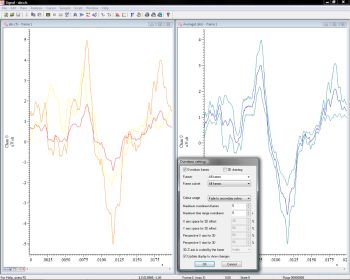Applications
Motor evoked potentials
Control magnetic stimulator parameters directly from Signal. Detect and plot response latency and peak amplitudes to XY trend plots automatically on-line or off-line.
Somatosensory evoked potentials
Use digital outputs or generate analogue waveforms to trigger and control voltage and current stimulators.
Auditory evoked potentials
Generate tone pips and play out pre-recorded sounds as stimuli using the 1401 DAC outputs. Control the CED 3505 programmable attenuator using digital outputs and audiometers using the RS232 serial line via the script language.
Visual evoked potentials
Digital outputs and serial line control can be used to interface with visual stimulus generators, including the ViSaGe and VSG range from Cambridge Research Systems, and experiment control programs such as E-Prime and Presentation to ensure accurate timing relative to sampling.

Auditory brainstem response recording using multiple
stimulus states and fast triggers mode
Registered in England: 00972132
Registered office:
- Cambridge Electronic Design Limited,
- Technical Centre,
- 139 Cambridge Road,
- Milton,
- Cambridge CB24 6AZ
- ENGLAND.
VAT: GB 214 2617 96
Producer registration number: WEE/BD0050TZ
For our US customers, we can provide tax form W-8BEN, that identifies us as a UK company.
CAGE/NCAGE: KB797
NAICS: 423490
Hardware: 84716070
Software: 85235190
By email:
By post:
- Cambridge Electronic Design Limited,
- Technical Centre,
- 139 Cambridge Road,
- Milton,
- Cambridge CB24 6AZ
- ENGLAND.
By telephone:
(Int.+44) (0)1223 420186
From North America (Toll Free):
1 800 345 7794










